ilknives
Knifemaker / Craftsman / Service Provider
- Joined
- Oct 19, 2017
- Messages
- 414
Careful with the pronunciation...!
Made myself this blade to try out a few things:
1. Wrought iron cladding
2. Getting Aogami Super super hard
3. Passive galvanic protection
This is the hardest steel I have worked with by far. I have used S110V and stopped because even in the annealed state it ruined my bandsaw blades. I use a Tormek sharpener and replaced the standard grinding wheel with a silicon carbide one to make light work of high hardness alloys. It normally takes me 5-15min to sharpen a blade, this took 40min+. I almost gave up, I lost a bit of concentration and the final bevel is not entirely to my liking but I am not going to try to correct it. There are also a couple of micro-cracks in the edge and I should really grind them out and re-sharpen but won't for the same reason. Oh, and when the carbide cutter I use to cut my maker's mark, hit the Aogami Super layer, it's tip broke.
The galvanic/electrochemical protection is a disc of pure magnesium pressed into the blade. I noticed that some billets I forged started to corrode, my shop is not heated but it is insulated and never goes below 12 deg C. So I found out it is galvanic potentials between the scale and the steel that make it happen so I thought (I have heard of it before as I am sure some of you have as well) why not try it on a blade? I know the ideal situation is there should be an electrolyte (food in the case of a blade) but my billet rusted in a dry environment... There is a patent for a diving knife with a current pushed galvanic protection cell in the handle. The thing is this worked so well that I almost couldn't get the blade to etch, you'll notice the wrought iron cladding looks pretty much the same as it did before it went in the ferric chloride! Probably better to install it after the grinding and etching but this blade is very thin to start with and I did not fancy it going under a 30T press.
The titanium handle is fixed with 3 titanium pins installed with hydraulic pressure and it is anodised, because, why not?! It was anodised whilst on the blade and created interesting patterns at the junction.
26cm/10,2 inches and 85g/3 ounces, 45g-180g BESS
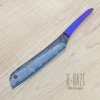
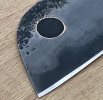
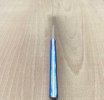
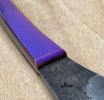
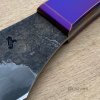
Made myself this blade to try out a few things:
1. Wrought iron cladding
2. Getting Aogami Super super hard
3. Passive galvanic protection
This is the hardest steel I have worked with by far. I have used S110V and stopped because even in the annealed state it ruined my bandsaw blades. I use a Tormek sharpener and replaced the standard grinding wheel with a silicon carbide one to make light work of high hardness alloys. It normally takes me 5-15min to sharpen a blade, this took 40min+. I almost gave up, I lost a bit of concentration and the final bevel is not entirely to my liking but I am not going to try to correct it. There are also a couple of micro-cracks in the edge and I should really grind them out and re-sharpen but won't for the same reason. Oh, and when the carbide cutter I use to cut my maker's mark, hit the Aogami Super layer, it's tip broke.
The galvanic/electrochemical protection is a disc of pure magnesium pressed into the blade. I noticed that some billets I forged started to corrode, my shop is not heated but it is insulated and never goes below 12 deg C. So I found out it is galvanic potentials between the scale and the steel that make it happen so I thought (I have heard of it before as I am sure some of you have as well) why not try it on a blade? I know the ideal situation is there should be an electrolyte (food in the case of a blade) but my billet rusted in a dry environment... There is a patent for a diving knife with a current pushed galvanic protection cell in the handle. The thing is this worked so well that I almost couldn't get the blade to etch, you'll notice the wrought iron cladding looks pretty much the same as it did before it went in the ferric chloride! Probably better to install it after the grinding and etching but this blade is very thin to start with and I did not fancy it going under a 30T press.
The titanium handle is fixed with 3 titanium pins installed with hydraulic pressure and it is anodised, because, why not?! It was anodised whilst on the blade and created interesting patterns at the junction.
26cm/10,2 inches and 85g/3 ounces, 45g-180g BESS





